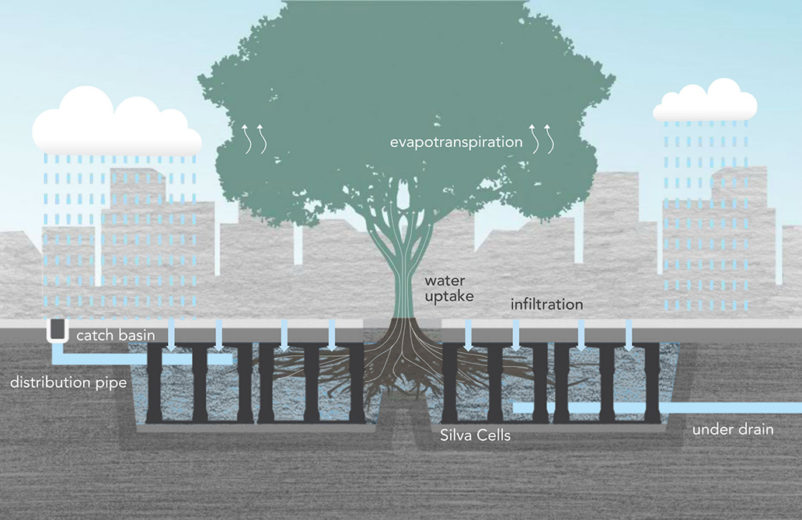Overview
Whole sites are considered when LEED credits are being assigned. The criteria to receive credits for on-site stormwater management are based on low-impact development (LID)/green infrastructure (GI) best management practices (BMP) controlling a specific design storm (i.e., runoff volume). These criteria can vary depending on the situation from the 85th percentile storm up to the 98th percentile storm.
More detail can be found in “LEED Building Design and Construction” (p. 37) and “LEED Neighborhood Development” (p. 71). Both documents reference “Technical Guidance on Implementing the Stormwater Runoff Requirements for Federal Projects under Section 438 of the Energy Independence and Security Act,” an Environmental Protection Agency (EPA) stormwater guidance document, and state that bioretention is an acceptable LID/GI BMP, describing it as follows (US EPA, 2009):
“On-lot retention of stormwater through the use of vegetation, soils, and microbes to capture, treat and infiltrate runoff. It is assumed bioretention practices would be installed within currently landscaped pervious areas or that pervious areas would be created for bioretention cells. While termed bioretention, these systems are designed to provide infiltration as well as temporary storage. Bioretention areas would be designed to accept up to a depth of 10 inches of water across the surface of the bioretention cell (see Appendix A). The conceptual design of this storage depth would occur within the media and/or could be included as ponded storage. Further design storage beyond the 10 inches would be acceptable (and encouraged) above the media on a site-by-site basis with ponded depth generally not to exceed 12 inches.” (Emphasis added)
Silva Cells, a suspended pavement system used to create subsurface rooting area and bioretention (Page et al., 2015), can be designed to control and treat a specified design storm to receive LEED credits at that level.

Schematic drawing of Silva Cells for stormwater management
Sample Calculations
The equation to calculate storage depth based on surface storage and soil depth is described below (Page et al., 2015):
Here is a sample calculation to determine the LEED V4 storage depth requirements using a 2x Silva Cell system:
2x Silva Cell depth = 32″ (812.8 mm)
Ss = 2”(51 mm)
Sd = 30”(762 mm), with porosity assumed to be 0.35(Brown et al., 2013) and field capacity of 0.18(USDA 1955)
Storage depth achieved in this scenario is 12.5”, or 318mm
If you are asked to calculate storage depth for the system at field capacity, use the difference of porosity and field capacity outlined below to estimate void space available for storage on runoff in the soil. This may be considered a more accurate (and conservative) estimate of field conditions.
Storage depth achieved in this scenario is 7.1” (170 mm), which is less than the 10” storage depth described in the US EPA (2009) design guidance. There are two possible solutions to increase the total storage depth in the system: (1) increase the surface storage or air space (e.g. from 2”to 6”) and/or (2) add a third layer of Silva Cells to increase the overall soil depth.
Solution 1: Here, SS is increased from 2” (51 mm) to 6” (152 mm), which subsequently decreases SD from 30” (762) to 26” (660 mm) in the 2x Silva Cell system:
Solution 2: Here, SS is increased slightly to 3”” (76 mm), and Sd is increased to 45” (1143 mm) in the 3χ Silva Cell system:
Both alternatives allow the designer to adjust the system components such that the 10” (254 mm) storage depth described in US EPA (2009) is met.
References
Brown, R.A., Skaggs, R.W., Hunt III, W.F., 2013. Calibration and validation of DRAINMOD to model bioretention hydrology. J. Hydrol. 486, 430–442.
Page, J. L., Winston, R. J., & Hunt III, W. F. (2015). Soils beneath suspended pavements: An opportunity for stormwater control and treatment. Ecological Engineering, 82, 40-48.
United States Department of Agriculture (USDA), 1955. Water. Year Book of Agriculture. United States Department of Agriculture (USDA), Washington, D.C.
United States Environmental Protection Agency (US EPA), 2009. Technical Guidance on Implementing the Stormwater Runoff Requirements for Federal Projects under Section 438 of the Energy Independence and Security Act. Office of Water, Washington, D.C.
Written correspondence with Jonathan Page, Extension Associate Engineer, North Carolina State University.